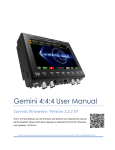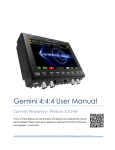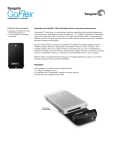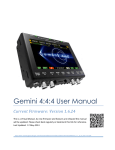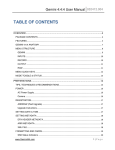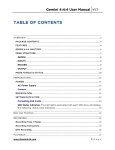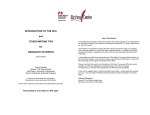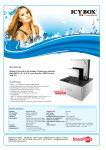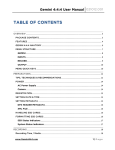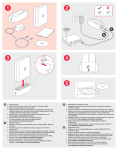Download Service Bulletin
Transcript
Convergent Design this issue Open Source Revolution P.1 IT Management Tips P.2 Non-Profit Solutions P.3 Trends & New Software P.4 Synopsis In order to avoid catastrophic data loss, and reap the best use of your Convergent Design SSD cards, it is imperative you read this document thoroughly. This Service Bulletin is intended to educate and draw awareness to best practices including, but is not limited to, the following: ALWAYS RECORD TO THE INTERNAL MEDIA ON THE CAMERA; THIS IS CRITICAL FOR PROPER TIMECODE AND IDEAL FOR DUAL MEDIA / BACKUP. Do not pull power or media (SSD, SxS, CF) from the unit or your camera during record or playback: This may result in data loss that is unrecoverable. Always ensure the Gemini 4:4:4 power source (battery, AC or power tap off the camera) can supply at least 20 watts to the Gemini (to support both average and instantaneous power). Always, always use 3G rated SDI cables. We highly recommend switching from the original eSATA transfer station to the new Universal Transfer (available free of charge from Convergent Design). Please take time to read through the User Manual to avoid these and other catastrophic losses. It is also best to maintain the latest firmware, so check the website regularly for updates, and make sure you are registered to receive email/newsletters so that we can contact you when available. www.convergent-design.com ++720.221.3861 Background Click Here for the User Manual, or scan the QR Code. P.1 Background The 256 and 512GB 1.8” SSDs (Solid-State Drives) utilized with the Gemini 444 recorder offer a tremendous amount of reliable storage in a very small form factor. They are marvels of advanced semiconductor processing, packing upwards of 600 Billion transistors in a package that fits in the palm of your hand. These high density SSDs offer amazing data-rates, up to 500MB/sec read and 260MB/sec write speeds, enabling recording of uncompressed HD and raw video up to 4K resolution. But high data-rates require associated high-power, as the I/O throughput is achieved by reading / writing to eight (or more) individual ICs (integrated circuits) in parallel. The highest power requirement occurs during a write operation, where power consumption of 5 watts per 512GB SSD is not uncommon. Power consumption is directly dependent on the write speed, the greater the power. Additionally, high frame-rate (48/50/60 fps) video requires writing video to two SSD drives in parallel, which can raise the overall SSD power to close to 10 Watts. Add the power requirements for the LCD and other control circuit and total Gemini power can reach 16 watts. SSD drives are very sensitive to power glitches, especially during write operations. A significant drop in the voltage can cause an errant write in the SSD, which can corrupt a frame of video, scramble the file directory/FAT or worse case cause an unrecoverable drive failure. Power management is therefore crucial for reliable operation. Particularly challenging is managing the power spike which occurs during the transition from idle mode to record as well as closing the files at the conclusion of a record session. Power can instantly jump from 6 to 16 watts when the record button is pressed. So a power system that seemed adequate in idle mode (live view) may instantly cause the Gemini to reboot and wipe out one or more SSDs during the transition to record mode. Inadequate power can also cause failures during file closing at the end of a record session, which causes a second spike (due to updating FAT tables, etc). Additionally, insufficient SSD power can also lead to failures during the offload of video data from the SSD to a computer or loading new Gemini firmware updates onto the SSD. Anytime an SSD is connected to a PC/MAC, the operating system may perform file indexing operations, which can result in write operations to the SSD. Even in idle mode, SSDs perform housekeeping operations (such as wear leveling and garbage collection) which result in write operations. That’s why it’s also best to perform an “eject” before removing any flash based memory (including USB drives and SSDs). Best Practices With this background in SSD power requirements, we offer the following best practices in handling SSDs: SSDs in Gemini 4:4:4 Ensure the power supply (battery, AC or power tap off the camera) can supply at least 20 watts to the Gemini (to support both average and instantaneous power). In particular do not use “Y” cables off the +12V power tap on the ALEXA. Do no attempt to power multiple devices (Gemini + LCD monitor) from this power source. P.2 Do not run your batteries down to zero charge, stop at 15% remaining capacity to enable adequate power to record and close files. If you do lose power while recording, remove the SSD’s and use other SSD’s for further recording. If you repower the camera and Gemini 4:4:4, then record on the same SSD’s, the footage recorded after the power failure will be inaccessible. NEVER remove an SSD while recording or playing video. This can cause catastrophic failure of the drive and resultant lost footage. If you accidentally cause a drive failure, you may be able to recover the drive by removing the video cables to the Gemini 4:4:4, removing other SSD’s, then inserting the SSD in a (powered) Gemini and waiting upwards of 20 minutes for the drive to rebuild itself. After 20 minutes, power off the Gemini 4:4:4, wait 5 seconds, then power it on again. If the recovery was successful, then the SSD LED will turn green after about 10 seconds or so. We may also be able to recover the files. Please contact tech support for more details. If an SSD does recover, please sequester this drive and do not record any additional video to this drive. We may be able to recover the last “take” if no additional recording is added to the card. Again, please contact tech support for additional guidance. Transferring SSD Video Using PC/MAC, Updating Firmware Due to the marginal power output of most USB power supplies, we recommend switching from the original eSATA transfer station to the new Universal Transfer Station as soon as possible. The Universal Transfer station has a built-in (AC) power source, with more than adequate power to ensure safe transfers of SSD data PC/MAC. This new transfer station is compatible with the following adapters from the hard-drive manufacturer, Seagate. The transfer method is listed in preferred order: 1st Gen – eSATA www.convergent-design.com ++720.221.3861 2nd Gen – Universal Transfer Station P.3 NOT INCLUDED, PLEASE PURCHASE SEPARATELY Thunderbolt: Seagate GoFlex Model STAE121 We have measured 325-375MB/sec transfer rates to a fast RAID drive, depending on your configuration. USB 2.0 / 3.0: Seagate GoFlex Model STAE104 or Calvary USB 3.0 Adapter, Model CAUSM2001. An ExpressCard 34 to USB 3.0 adapter may be required for full USB 3.0 compatibility. However, USB 2.0 works fine to d copy Gemini firmware updates to the SSD. Firewire 800: Seagate GoFlex Model STAE102 This is the slowest interconnect (other than USB 2.0), but it’s a safe method to copy files. If you do not have one of the new FREE universal transfer stations, please contact your local dealer or visit our website: http://convergent-design.com/Products/Gemini444/GeminiTransfer.aspx. If eSATA is the only viable option for SSD data transfer, we recommend using an external AC powered USB supply rated at 10 Watts. An excellent choice is the iPad power supply, which provides USB power. Do not use the USB power from your PC/MAC to power the eSATA transfer station. We do NOT recommend eSATA adapters for Mac’s running OSX Lion/Mountain Lion. BNC Cables Poor quality BNC cables can result in lost and/or corrupted video and otherwise unreliable operation. This problem has become more widespread with the use of 3G (3 GHz) video throughout the industry. We therefore offer the following recommendations: www.convergent-design.com ++720.221.3861 P.4 Always, always use 3G rated SDI cables. It’s too easy to switch from 1.5G dual link to 3G single link and forget to switch to a better grade SDI cables. Toss out all those older 1.5G cables and avoid all the headaches (note the supplied cables with the Gemini work great at 3G). Extra HD-SDI 3G Rated Cables, identical to the ones included with the Gemini 4:4:4, may be ordered from your local dealer. It is a great idea to have spares on hand. Never add a “T” or chain SDI cables together. The introduction of a connector distorts the signal quality leading to possible errors in the video. Pay attention to the “Check SDI cable” message in the new firmware. This indicates that the Gemini is detecting a CRC error in the video. A faulty cable is the most likely culprit. Powering the Gemini Finally, we come to the most common Gemini issue, providing power with the correct voltage and polarity. As mentioned in the SSD section, adequate power (20 W) is critical for proper operation of the Gemini, particularly during record. So, here’s a short list of recommended practices regarding power: Always double-check the polarity of the incoming power connection. Just like over-voltage, reverse-voltage will damage the internal power protection circuit requiring a return of the Gemini to the factory for repair. Shown below is the pin-out for the 4-pin Hirose power connector used in the Gemini. 1) 2) 3) 4) Power: +6.5 ~ +19V Power: +6.5 ~ +19V Ground Ground Note: Positive Power must be connected to both Pins 1 & 2. Ground must be connected to both Pins 3 & 4. The Gemini power is rated to operate from +6V to +19V, never under any circumstances, exceed this voltage. The Gemini power is not directly compatible with the 3-pin RS power port from the ALEXA, which nominally outputs +24V. Likewise direct connection to a +28V battery will cause immediate damage to the Gemini voltage input protection circuit, necessitating an RMA return to the factory for repair. www.convergent-design.com ++720.221.3861 Be extra careful not to plug the power in the remote receptacle, located on the opposite side of the recorder. This will also cause a permanent failure, requiring a return to the factory for repair. P.5 Convergent Design offers a over-voltage/reverse-voltage protection module which mounts on the side of the Gemini and plugs into the power receptacle. This power module works by blocking the power to the Gemini 4:4:4 or nanoFlash if the voltage is over 19 Volts, or if the polarity is reversed. When these conditions occur, zero volts will be provided to the Gemini or nanoFlash, thus protecting them from damage. If you would like to add this protection, the modules are available at no-charge, simply send a request to our customer support, [email protected]. If the nanoFlash or Gemini 4:4:4 will not power up, check your cables for proper voltage and polarity. If you assume that the power protection module is defective, and connect your power cable directly to the Gemini 4:4:4 or the nanoFlash, and the power is bad, then you will damage the Gemini 4:4:4 or nanoFlash. Convergent Design will soon offer a DC to DC converter with a +10V to +34V input with a +8V @ 3A output to power the Gemini (also works on the nanoFlash). The converter also includes overvoltage/reverse-voltage protection. These converters will be available in September 2012 through authorized Convergent Design dealers. Price is TBD. Convergent Design Support Team If you encounter problems with the Gemini or simply need guidance operating our recorder with any camera, please feel free to contact our support team: Andy Mangrum, Technical Support Dan Keaton, Sales and Marketing Director Tina Johnson, Customer Support (RMA’s) Craig Mayher, Repair Technician www.convergent-design.com ++720.221.3861 [email protected], ++720-221-3861 (W) [email protected], ++803-278-0941 (W), ++719-930-1376 (C) [email protected], ++720-221-3861 (W) [email protected], ++720-221-3861 (W) P.6







